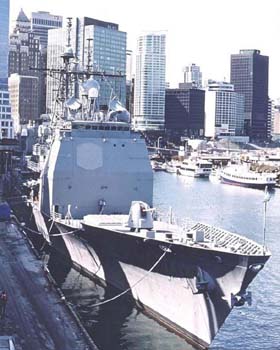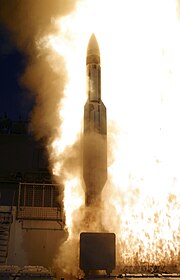Missile Defense Agency, Japan Defense Agency and Lockheed Martin Complete Successful Missile Defense Test
(Source: Lockheed Martin; issued March 8, 2006)

KAUII, Hawaii --- The Aegis-equipped cruiser USS Lake Erie (CG-70) successfully launched a Standard Missile (SM)-3 with a cooperatively engineered, experimental nosecone.
The experimental nosecone is the result of joint cooperative research by the Missile Defense Agency (MDA), Japan Defense Agency (JDA) and U.S. and Japanese industry. Lockheed Martin, as the U.S. Navy's combat systems engineering agent for the Aegis Ballistic Missile Defense (BMD) System, provided the system engineering to integrate the experimental Raytheon SM-3 missile configuration into the Aegis BMD Weapon System.
The test, Joint Control Test Vehicle-1 (JCTV-1), was the first flight test of the experimental nosecone. In the standard SM-3 configuration, the missile must maneuver to eject the nosecone, uncovering the exoatmospheric kill vehicle, which is then deployed to intercept the target. In the experimental configuration, the nosecone opens like a clam shell to more quickly uncover and release the kill vehicle without any missile maneuvers. The flight test mission objectives included evaluation of the advanced nosecone design and characterization of the Aegis BMD Weapon System's performance using this design.
"This is a great example of international teamwork focused on extending the protection provided by the Aegis BMD Weapon System," said Jimmy Carter, Lockheed Martin's director for International Aegis BMD Programs.
The MDA and the U.S. Navy are jointly developing Aegis BMD as part of the United States' Ballistic Missile Defense System (BMDS). Ultimately 15 U.S. Navy Aegis destroyers and three Aegis cruisers will be outfitted with the capability to conduct Long Range Surveillance and Tracking (LRS&T) and engagement of short and medium-range ballistic missile threats using the Aegis BMD Weapon System and its SM-3 missile. To date, 11 Aegis destroyers have been upgraded with the LRS&T capability and two Aegis cruisers have been outfitted with the emergency engagement and LRS&T capability.
Japan is modifying the first of up to four Kongo-class Aegis-equipped destroyers with the Aegis BMD system.
The Aegis Weapon System is the world's premier naval surface defense system and is the foundation for Aegis BMD, the primary component of the sea- based element of U.S. BMDS. Aegis BMD seamlessly integrates new capabilities of the SPY-1 radar, the MK 41 Vertical Launching System and adds the SM-3 missile into the existing Aegis Weapon System's command and control system. Aegis BMD is also integrated with BMDS, receiving cues from and providing cueing information to other BMDS elements.
The Aegis Weapon System is currently deployed on more than 77 ships around the globe with more than 25 more ships planned. In addition to the U.S., Aegis is the maritime weapon system of choice for Japan, South Korea, Norway and Spain. Recently, Australia selected Aegis for its new Air Warfare Destroyer program.

 Win a FREE Membership!
Win a FREE Membership!